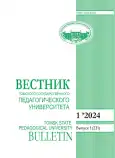№ 1 (2024)
ТЕОРИЯ И МЕТОДИКА ОБУЧЕНИЯ И ВОСПИТАНИЯ
Глаголы слухового восприятия в автобиографической прозе (на материале произведения Ирины Одоевцевой «На берегах Невы»)
Аннотация
 33-40
33-40


ТЕОРЕТИЧЕСКАЯ И ПРИКЛАДНАЯ ЛИНГВИСТИКА
Сетевой диаспоральный дискурс: определение понятия
Аннотация
 7-14
7-14


Понятийное моделирование терминосистемы градостроительства
Аннотация
 15-22
15-22


Растительная метафора в китайском языке: семасиологический и когнитивный аспекты
Аннотация
 23-32
23-32


Интернет-откровение как речевой жанр
Аннотация
 41-49
41-49


СОПОСТАВИТЕЛЬНАЯ ЛИНГВИСТИКА
Особенности перевода безэквивалентной лексики в романе И. Ильфа и Е. Петрова «Золотой теленок» на английский язык
Аннотация
 50-58
50-58


Сопоставительное исследование актуального членения предложения в русском и персидском языках
Аннотация
 59-67
59-67


РУССКИЙ ЯЗЫК. ЯЗЫКИ НАРОДОВ РОССИИ
«Еще раз говорю…»: повторение сказанного как средство снятия неопределенности
Аннотация
 68-76
68-76


Образ роз в лирике М. И. Цветаевой: семантико-стилистический анализ
Аннотация
 77-86
77-86


Когнитивная структура глагола слуховой перцепции иһит в якутском языке
Аннотация
 87-96
87-96


Обучение текстовой деятельности на уроках русского языка: возможности использования текстов с дополненной реальностью
Аннотация
 97-105
97-105


МЕТОДИЧЕСКИЕ АСПЕКТЫ СОВРЕМЕННОЙ ФИЛОЛОГИИ
Отношение вьетнамских студентов к развитию навыков устной и письменной речи русского языка при помощи социальных сетей: количественное исследование
Аннотация
 106-113
106-113


РУССКАЯ ЛИТЕРАТУРА И ЛИТЕРАТУРЫ НАРОДОВ МИРА
Прошлое и будущее в Home Life in Russia: Чичиков и помещики
Аннотация
 114-122
114-122


Предчувствие национальной катастрофы в публицистике и эго-документах Л. Андреева 1917–1919 гг.
Аннотация
 123-131
123-131


Неомифологические способы воплощения темы наставничества в романах Мариам Петросян «Дом, в котором…» и Виктора Козько «Хроніка дзетдомаўскага саду»
Аннотация
 132-140
132-140


Нельсон Родригес и современная трагедия
Аннотация
Бразильский драматург Нельсон Родригес – автор очень своеобразного драматического произведения, основные черты которого связаны с поэтикой избытка и модернизацией трагедии. В его творчестве есть два направления: одно ближе к общечеловеческим и мифологическим аспектам жизни, а другое ближе к историческим и бытовым аспектам. Его собственная жизнь была полна трагических событий, которые заставили его почувствовать, что трагедия – это измерение, которое неотъемлемо принадлежит траектории человечества в этом мире. Так что трагический смысл жизни был частью его мировоззрения и его философских концепций. Тогда было естественно, что это трагическое мировоззрение будет присутствовать в его литературном творчестве в нескольких жанрах, которые он исследовал, особенно в его драматических произведениях. Но в его трагическом подходе всегда смешаны мелодраматические события и избыток чувств, поступков и гротеска, так что он часто становится одновременно и комическим. На Нельсона Родригеса повлияла как высокая художественная литература западной традиции, так и сублитература начала XX в., и их смесь составляет оригинальное и очень интересное творение. В статье рассматривается трагическое как принадлежащее жизни драматурга, его мировоззрению и творчеству путем анализа событий в его произведениях, чтениях, оперных и кинематографических приемах, с которыми он был знаком, чтобы отразить их влияние на его творчество, а также обсудить формальные аспекты и темы, позволяющие считать его драматические произведения принадлежащими к традиции трагедии, хотя он ниспровергал и воссоздавал трагические стандарты на свой лад.
 141-148
141-148









